A Comprehensive Guide to Jewelry Stones: Names & Significance


Intro
The world of gemstones is vast and intricate, reflecting a tapestry of natural beauty, history, and value. As both collectors and admirers deepen their appreciation for these well-crafted stones, understanding their nuances becomes essential. This guide aims to illuminate various jewelry stones, offering a detailed exploration that encompasses their names, properties, and significance.
Gemstone enthusiasts often seek to delve into both the practical and historical aspects of the stones they cherish. This article provides insights that are not only informative but also captures the complexity of gemstones, ranging from the familiar to those that are lesser-known. To navigate this rich subject matter, let us begin with an overview of gemstones.
Gemstone Overview
Definition and Characteristics
Gemstones are precious or semi-precious stones that have been cut and polished for use in jewelry and decoration. Their allure can be attributed to a combination of factors including color, brilliance, rarity, and durability. Each gemstone exhibits specific characteristics that influence its value and desirability:
- Color: The visible hue or combination of hues. Different varieties include sapphire blue, emerald green, and diamond clear.
- Clarity: The absence of inclusions or blemishes. A clearer stone is generally considered more valuable.
- Cut: Refers to how well a gemstone has been shaped and faceted. The cut affects brilliance and sparkle.
- Carat Weight: Measures the size of the stone. Heavier stones tend to be pricier, but value also depends on other factors.
Classification of Gemstones
Gemstones can be classified into two main categories: precious and semi-precious. Precious gemstones include diamonds, rubies, sapphires, and emeralds. These stones are typically more valuable due to their rarity and unique properties. Semi-precious stones such as amethyst, garnet, and citrine, while still beautiful, are more commonly found and usually more affordable.
"Understanding the classification of gemstones helps collectors make informed decisions on purchases and collections."
Additionally, gemstones can also be classified by their origin:
- Natural stones: Formed through geological processes over time.
- Synthetic stones: Man-made stones that replicate the appearance and properties of natural gemstones.
- Precious stones: Those prized for their beauty and rarity.
Historical Significance
Ancient Uses and Cultural Importance
Gemstones have held significance throughout history, often connected with mythology, status, and wealth. Ancient Egyptians adorned themselves with lapis lazuli and turquoise, believing these stones offered protection and power. In various cultures, including those in India and China, gemstones were used as talismans or in religious practices.
Moreover, gemstones have often been associated with royalty. Crowns and royal garments were frequently embedded with emeralds, rubies, and diamonds, symbolizing power and wealth.
Myths and Legends Surrounding Gemstones
Numerous myths surround gemstones, contributing to their allure. For example, the ruby is said to symbolize passion and protection. Specific beliefs include:
- Amethyst: Thought to prevent intoxication.
- Opal: Considered a stone of luck and hope.
- Pearls: Associated with purity and innocence.
Understanding these myths adds a layer of richness to the appreciation of gemstones, connecting them to human history and experience. As we continue through this guide, we will explore more about specific stones and their significance in detail.
Preface to Jewelry Stones
The realm of jewelry stones extends far beyond mere aesthetics. Understanding jewelry stones is essential not only for collectors but also for designers and enthusiasts who appreciate the intricate interplay between nature, culture, and craftsmanship. This section emphasizes the significance of jewelry stones, laying the groundwork for deeper exploration in subsequent sections.
Definition of Jewelry Stones
Jewelry stones, commonly referred to as gemstones or gem materials, are naturally occurring minerals that are often cut and polished to create beautiful pieces for adornment. They may also include organic materials, such as pearls or amber. The fundamental characteristic of these stones is their ability to captivate and charm; they serve as a testament to Earth's geological processes over millions of years. The classification of jewelry stones involves various categories, including precious, semi-precious, and synthetic variants. This distinction affects not only their value but also their significance in different cultural contexts.
Importance in Culture and Art
Jewelry stones have played a pivotal role in various cultures throughout history. From ancient civilizations to modern societies, the allure of stones like diamonds, sapphires, and emeralds has transcended time. Each stone carries unique narratives, often intertwined with mythology and tradition.
- Symbolism: Many stones possess symbolic meanings. For example, diamonds often represent strength and eternal love, while sapphires are linked to wisdom.
- Cultural Significance: In different cultures, certain gemstones are believed to bring good fortune or act as protective talismans. Their presence in ceremonial artifacts underscores their importance in societal rituals and celebrations.
- Artistic Expression: Furthermore, artists and jewelers leverage these stones to create stunning masterpieces. The craftsmanship involved in setting these stones elevates their status, integrating artistry with cultural expression.
The examination of jewelry stones reveals not just their physical beauty, but also their deep-rooted connection to human stories. This guide aims to delve into the multifaceted nature of these stones, enriching our understanding of their significance.
Classification of Jewelry Stones
The classification of jewelry stones is a crucial topic within the broader context of gemstones. Understanding these categories allows enthusiasts and jeweler designers to make informed decisions regarding selection, valuation, and care. Jewelry stones can be broadly classified into two main categories: precious and semi-precious. Each classification reveals important insights about the stone’s rarity, durability, and market value.
Precious vs. Semi-Precious Stones
The distinction between precious and semi-precious stones is foundational. Traditionally, precious stones are those like diamond, emerald, ruby, and sapphire. These are typically valued for their rarity, beauty, and hardness. For instance, diamonds are renowned not only for their hardness but also for their brilliance, making them a staple choice for engagement rings.
On the other hand, semi-precious stones include a wider range of gemstones such as garnet, amethyst, and citrine. These stones, while still beautiful and valuable, generally do not carry the same market weight as their precious counterparts. This does not diminish their aesthetic appeal or significance in jewelry making. The classification can influence pricing significantly. Collectors and designers often assess both categories based on individual tastes and preferences.


"Understanding the classification of gemstones can greatly enhance the appreciation of jewelry pieces and their intrinsic value."
Natural, Synthetic, and Imitation Stones
When discussing jewelry stones, it is also vital to distinguish between natural, synthetic, and imitation stones. Natural stones are formed through geological processes without human intervention. These stones possess unique characteristics and often carry historical value.
Synthetic stones, like cubic zirconia or lab-created sapphires, are manufactured to simulate natural gems. These stones can be produced with nearly identical appearances to their natural counterparts but at a significantly lower cost. While they can replicate the look and some properties of natural stones, they may differ in terms of value and some physical features.
Imitation stones, on the other hand, are meant to look like genuine gemstones but are made from entirely different materials. An example of this is glass jewelry that mimics the appearance of opal or turquoise. Understanding these distinctions helps consumers make better-informed decisions, particularly concerning ethical considerations in gemstone purchases and the authenticity of jewelry pieces.
Popular Jewelry Stones and Their Names
Understanding popular jewelry stones is not just about recognizing names but also about appreciating their significance in jewelry design and cultural history. Each gemstone comes with its own story, unique characteristics, and value, making them not just adornments but also cherished items that symbolize emotions and moments. For enthusiasts and collectors, knowing these gems can enhance their selection process, investment strategy, and personal connection to their pieces.
Diamond: Unrivaled Brilliance
Diamonds are often celebrated as the epitome of luxury and romance. Their composition of carbon atoms arranged in an octahedral structure leads to incredible hardness and brilliance. Diamonds score a perfect 10 on the Mohs scale of mineral hardness, making them the hardest known natural material. This durability crucially influences their desirability in engagement rings, where they symbolize everlasting love.
The value of a diamond is frequently assessed through the Four Cs: cut, color, clarity, and carat weight. The cut, which affects the gemstone's ability to reflect light, can transform a mere stone into a stunning piece of art. Modern technology allows for precision cuts that maximize sparkle. However, other factors such as color and clarity also significantly influence a diamond's allure. Interestingly, colored diamonds, such as blue or pink variations, have gained popularity in recent times, broadening interests beyond the traditional clear stone.
Sapphire: The Blue Wonder
Sapphires evoke a sense of mystery and elegance. While blue sapphires are the most recognized, these gemstones come in various hues, making them remarkably versatile in jewelry design. The color is due to trace amounts of elements like iron and titanium within the corundum structure, creating mesmerizing shades that draw interest.
Sapphires are also durable gems, scoring a 9 on the Mohs scale, making them suitable for everyday wear. They have been used throughout history in royal engagements and ceremonial pieces due to their association with nobility and wisdom. Moreover, sapphires possess a fascinating place in metaphysics. Many believe that wearing sapphire can bring peace, prosperity, and protection to the wearer.
Emerald: The Gem of Rebirth
Emeralds are revered for their stunning verdant hue. The distinct green color arises from traces of chromium and vanadium within the beryl family, setting them apart from other gemstones. Traditionally, emerald is not only seen as a precious gem but also associated with rebirth and love. It has deep ties to historical royalty, often found in crowns and treasured artifacts.
However, emeralds have inclusions known as "jardin", or garden, which make each stone unique. These natural imperfections can actually enhance their charm rather than detract from it. Jewelry lovers value these imperfections and often select stones based on their distinctive qualities. Furthermore, in the realm of alternative medicine, emeralds are said to promote healing and even foster harmony within relationships.
Ruby: The King of Gems
Rubies, hailed as the "King of Gems," are known for their striking red color and unmatched desirability. The deep crimson is caused by chromium, and like sapphires, they belong to the corundum family. Scoring 9 on the Mohs scale, rubies are also robust choices for everyday jewelry. Their color symbolizes passion and courage, making them popular in both engagement rings and statement pieces.
The history of rubies can be traced back to ancient cultures that believed them to contain the power of life. They were often embedded in armor to protect the wearer in battles. In more recent times, rubies are seen as tokens of strong love and are given to celebrate milestones in romantic relationships.
Opal: A Kaleidoscope of Colors
Opals are unique as they present a play-of-color, creating an almost ethereal appearance. Unlike most gemstones, opals do not have a specific color and can reflect a myriad of shades. This property arises from the internal structure of the stone, which diffracts light in unusual ways. The variety of opals ranges from white to black, with precious opals showcasing vibrant colors.
Due to their delicate composition, opals rank lower on the Mohs scale, which makes them less suitable for everyday jewelry but perfect for special pieces. Each opal has its own personality, and this individuality makes them increasingly popular among collectors. In various cultures, opals are believed to bring good luck and enhance creativity, further endearing them to jewelry lovers.
"Each gemstone tells a story, and knowing them deepens our appreciation and connection to our cherished collections."
Rare and Exotic Jewelry Stones
The realm of jewelry stones encompasses not only the widely known gems but also the rare and exotic varieties that captivate collectors and enthusiasts. This section highlights the significance of these stones and their unique qualities. Rare and exotic stones often possess distinctive features, including remarkable hues and optical effects that create a fascination among those who appreciate the art of gemstones. Their scarcity also contributes to their value, making them more desirable in both personal collections and investment opportunities.
In any comprehensive guide, including rare and exotic jewelry stones enriches the reader's understanding of the vast diversity within the gem world. With a deeper appreciation of these stones, collectors can make informed decisions about acquisitions. Knowledge of their attributes assists in recognizing and valuating pieces that may not be mainstream but are nonetheless exceptional.
These stones also have historical and cultural significance. Many have a storied past, steeped in myths and legends. Understanding their origins can provide insight into their importance beyond mere aesthetics. Furthermore, rare stones can symbolize personal milestones or achievements, making them unique gifts or personal treasures.
"The rarity of a gemstone often correlates with its allure and market value, bringing together both collectors and investors in a shared passion for the extraordinary."
Alexandrite: Color Change Phenomenon
Alexandrite is a remarkable gem known for its captivating ability to change color. In daylight, this stone appears greenish or bluish-green, but in incandescent light, it shifts to a warm reddish or purplish hue. This striking characteristic is a result of the stone's unique chemical composition, primarily consisting of chrysoberyl.
The color change of alexandrite is fascinating, drawing many to explore its mystique. This property is not only beautiful but also incredibly rare, as few stones exhibit such pronounced color alterations. Collectors especially seek out high-quality alexandrite due to its limited availability and the complexities involved in its formation.
- Location: Most alexandrite comes from Brazil and Russia, adding to its exclusivity.
- Value: Prices for alexandrite can be high, depending on its color change, clarity, and size.
- Symbolism: Alexandrite symbolizes luck and love, further enhancing its appeal.
Whether for personal adornment or investment, the exceptional qualities of alexandrite make it a subject worth studying.
Tanzanite: One-Location Wonder


Tanzanite is another precious gem that has captured the attention of gem enthusiasts. Found only in a small region near Mount Kilimanjaro in Tanzania, its unique one-location characteristic makes it particularly intriguing. Tanzanite exhibits a deep blue color, with some stones showing violet and burgundy hues when viewed from different angles—a phenomenon known as pleochroism.
The demand for tanzanite continues to grow, making it essential for collectors to recognize the factors that influence its value. Its vivid coloring and the distinct geographic origin contribute significantly to its market price.
- Rarity: Given its singular source, once supplies diminish, it may become even more valuable.
- Industry Impact: Increased demand has led to a rise in production techniques, some of which aim to enhance its natural colors.
- Symbol of Change: Many consider tanzanite a stone that represents transformation and new beginnings.
Tanzanite’s charm lies not only in its appearance but also in its unique story, making it a desirable piece in any collection.
Metaphysical Properties of Stones
The metaphysical properties of stones hold an intriguing fascination for many individuals. This interest often extends beyond their aesthetic value or financial worth. Gemstone enthusiasts and collectors frequently explore the realms of healing and spiritual significance associated with their favorite stones. Understanding these elements can greatly enrich both personal experience and professional practice.
Healing Properties
Healing properties attributed to gemstones are believed to aid in physical and mental well-being. Each stone is thought to possess unique vibrations, which resonate with different aspects of the human experience.
- Amethyst: Often linked to calmness, it is said to relieve stress and promote relaxation.
- Rose Quartz: Known as the stone of love, it encourages compassion and emotional healing.
- Citrine: This bright yellow stone is associated with prosperity and abundance, purportedly boosting confidence and motivation.
Individuals may incorporate these stones into their wellness routines. Whether worn as jewelry or placed in personal spaces, their properties are thought to contribute positively to one's life. Yet, it is essential to note that while personal experience plays a significant role, scientific backing remains limited. The use of gemstones in healing should complement, not replace, traditional medical practices.
Spiritual Significance
The spiritual significance of stones often invites deep reflection and exploration. Many cultures and traditions assign specific meanings to various gemstones, linking them to spiritual growth, protection, and enlightenment. Understanding this aspect can deepen one’s connection to the stones they choose to wear or collect.
- Turquoise: Regarded as a protective stone, it is often used in rituals for safeguarding energy.
- Lapis Lazuli: This deep blue stone symbolizes wisdom and truth, often employed in prayer and meditation practices.
- Clear Quartz: Known as the master healer, it is believed to amplify energy and intentions.
Individuals looking for spiritual guidance or insight often gravitate toward certain stones during meditation or self-reflection. The connection between the physical presence of the stones and the intended journey of the user can create a profound experience.
Evaluating Gemstone Quality
Evaluating the quality of gemstones is critical for both collectors and casual buyers. Understanding gemstone quality can significantly affect purchasing decisions, investment values, and ultimately, the satisfaction derived from owning a piece of jewelry. The various elements that define quality—such as cut, color, clarity, and carat—inform buyers about the gem's aesthetic appeal, value, and longevity. Gaining this knowledge helps enthusiasts make informed choices and avoid common pitfalls.
The Four Cs: Cut, Color, Clarity, and Carat
The Four Cs are essential criteria used to assess the quality of a gemstone. Each factor plays a distinctive role in determining a stone's overall value and desirability.
- Cut: The cut refers to how the gemstone has been shaped and faceted. A good cut optimizes the stone's ability to reflect light, which enhances its brilliance. Poorly cut stones can appear dull, even if they possess other desirable qualities.
- Color: Color is often the most visible quality of gemstones, influencing both beauty and price. The depth and hue of color contribute significantly to a stone's appeal. For instance, sapphires are valued primarily for their rich blue tones, while emeralds are treasured for their deep green shades.
- Clarity: Clarity measures the presence of inclusions or blemishes within a stone. Higher clarity generally means better quality. However, certain stones may still be attractive even with minor imperfections, depending on the type and location of these flaws.
- Carat: Carat is a unit of weight that directly translates to size. While larger stones are often more valuable, size should be considered in context with the other Cs. A smaller stone with superior cut, color, and clarity may hold greater value than a larger yet inferior gem.
"Understanding the Four Cs enables buyers to appreciate the complexities of gemstones, directly influencing both value and beauty."
Certification and Grading
Certification serves as a guarantee of authenticity and quality. Gemological laboratories evaluate stones and give them grades based on the Four Cs. For example, a certificate from the Gemological Institute of America (GIA) or the American Gem Society (AGS) is highly regarded in the industry. Such certifications not only validate a gem's quality but also provide detailed narratives on its characteristics, which can be vital for future resale.
When buying gemstones, always seek certified pieces. Not all dealers provide this, but certified gemstones offer peace of mind and better investment potential. Always ask for quality assessments and verification documentation to ensure you are making a prudent purchase.
Market Trends in Gemstones
Understanding market trends in gemstones is essential for enthusiasts, collectors, and investors alike. The gemstone market is influenced by various factors that create shifts in demand and price. These trends not only impact what stones are popular but also dictate their potential resale value. An astute awareness of these shifts can guide informed purchasing decisions and enhance one's collection.
Demand Fluctuations
Demand for gemstones often ebbs and flows due to various economic and cultural factors. Social media has amplified exposure to different gemstones. Trends can emerge quickly based on celebrity endorsements or viral social media posts. For instance, the sudden interest in morganite is a testament to the influence of current fashion and celebrity culture.
Additionally, changing consumer values also drive demand. More buyers are prioritizing ethically sourced gemstones. Environmentally conscious consumers seek transparency regarding a stone's origin and mining practices. This shift is reshaping inquiries towards sustainable practices and influencing purchasing habits.
Here are some key factors affecting demand fluctuations for gemstones:
- Economic Conditions: Economic downturns can reduce discretionary spending. Collectors and investors may hold off on purchases during these times. Alternatively, prosperity can boost luxury item sales.
- Cultural Trends: Cultural celebrations, such as weddings or anniversaries, consistently create surges in demand for specific stones, like diamonds or sapphires.
- Fads and Collecting Trends: The interest in colored stones has fluctuated over the years, with demand often reverting to classic options, such as diamonds.
"Gemstone popularity can change overnight, driven by trends in social media and celebrity culture."
Investment Potential
The investment potential of gemstones has started to gain mainstream attention. Unlike traditional investments, gemstones offer a unique form of wealth that can appreciate over time. Investors drawn to the gemstone market often seek out specific characteristics that can enhance value.
When assessing the investment potential of gemstones, several factors come into play:


- Rarity: Rare stones tend to hold value better. For example, pink diamonds are both considered beautiful and rare, often fetching high prices at auctions.
- Quality Grades: Similar to evaluating gemstones for jewelry, the four Cs—cut, color, clarity, and carat weight—are crucial for investment quality. High-quality stones attract more buyers in the resale market.
- Market Demand: Understanding which gemstones are currently in demand can guide smart investment decisions. Predicting trends can result in advantageous timing for purchases and sales.
- Historical Value Trends: Analyzing the history of gemstone values can provide insight into potential future value fluctuations.
Investors must approach this market with diligence. It is advisable to engage with professional appraisers and gemologists who can provide insight into market trends and potential investments.
Caring for Jewelry Stones
Caring for jewelry stones is essential not only for maintaining their beauty, but also for ensuring their longevity. Each gemstone requires specific handling and maintenance methods suited to its unique properties. When properly cared for, jewelry stones can retain their luster and significance for generations. This section will delve into the key elements of cleaning and storing gemstones, highlighting the benefits and considerations involved in effective stone care.
Proper Cleaning Techniques
Keeping your jewelry stones clean is paramount. Dust, oils, and other residues can dull the surface and diminish the stone's appearance. Here are some recommended cleaning techniques:
- Soft Cloth: A simple yet effective method involves using a clean, soft, lint-free cloth. Wipe the gemstone gently to remove surface dust and grime.
- Mild Soapy Water: For deeper cleaning, mix warm water with a few drops of mild dish soap. Soak the stones briefly, then use a soft brush to clean between settings. Rinse with lukewarm water and dry immediately.
- Ultrasonic Cleaners: These devices can be effective for many types of gemstones. However, exercise caution. Avoid using them on softer stones, such as opal or turquoise, as these may get damaged.
Storage Recommendations
Proper storage is vital for protecting jewelry stones from scratches and damage. Follow these guidelines to ensure safe storage:
- Individual Compartments: Store each stone or piece of jewelry separately to prevent scratching. Use soft pouches or individual compartments in your jewelry box.
- Avoid Direct Sunlight: Store gemstones in a cool, dark place and avoid direct sunlight, which can fade colors over time.
- Humidity Control: High humidity can damage certain stones. Consider using silica gel packets in your storage area to absorb excess moisture.
When you take steps to clean and store your jewelry stones properly, you not only maintain their aesthetic value but also enhance their durability and market demand. Protecting your investment in jewelry stones is an understanding of their significance, beauty, and care.
Buying Jewelry Stones
Buying jewelry stones is a crucial aspect of both amateur and professional gem enthusiasts. A gemstone often represents more than its physical beauty; it encapsulates emotions, memories, and significance that vary from person to person. Therefore, understanding how to navigate the purchasing process can drastically improve the overall experience, ensuring that the buyer makes informed decisions that resonate well personally and financially.
Where to Purchase
When it comes to purchasing jewelry stones, the options available can be extensive. Buyers can consider various places, but the most common options include:
- Specialty Gemstone Shops: These stores often focus exclusively on selling gemstones and may offer a wider variety of stones. Experts typically staff them, giving buyers access to knowledgeable advice.
- Jewelry Stores: Established jewelry shops usually carry a range of gemstones embedded into pieces. They often provide customer service that helps buyers choose items tailored to their needs.
- Gem Shows: These events allow direct interaction with multiple sellers. Prices can vary greatly, and it’s an opportunity to see a lot of options in a single location.
- Online Marketplaces: Websites like eBay and Etsy facilitate buying from individual sellers or shops worldwide, often providing a vast selection of stones at various price points. Here, caution is essential due to the risk of misrepresented items.
- Auctions: Reputable auction houses sometimes sell rare gemstones, providing unique finds that are not available elsewhere. Buyers should research auction terms beforehand.
"Choose where to purchase based on your comfort level with stone quality and your willingness to invest time in research."
Online vs. Physical Stores
The decision between online shopping and physical stores hinges on multiple factors. Both platforms offer unique benefits and challenges that can significantly impact the buying experience.
Online Stores:
- Pros:
- Cons:
- Convenience: Online shopping allows buyers to browse extensive inventories from the comfort of home.
- Variety: The sheer volume of online sellers means access to a broader range of gemstones.
- Price Comparison: It is easier to compare prices across different sites.
- No Physical Inspection: Customers cannot physically assess the stone, which can lead to issues with quality or authenticity.
- Shipping Risks: There might be concerns over damage during shipping or delays.
Physical Stores:
- Pros:
- Cons:
- Direct Inspection: Buyers can physically inspect stones and assess their quality firsthand.
- Expert Guidance: In-person staff can provide immediate answers to questions and offer personalized recommendations.
- Limited Selection: A physical store may not have as many options as online platforms.
- Potential Higher Prices: The cost may be more due to overhead expenses.
The End
In this article, we have explored the multifaceted world of jewelry stones, delving into their names and significance. The conclusion serves as a vital element, encapsulating the key insights and broader implications of the information presented throughout the piece. Understanding these facets not only enhances one’s knowledge but also informs better decision-making in the realms of purchasing, caring for, and appreciating gemstones.
Recap of Key Points
To summarize, the exploration of jewelry stones can be broken down into several key themes:
- Understanding Types: We classified stones as precious, semi-precious, natural, synthetic, and imitation, clarifying their distinct characteristics.
- Popularity and Rarity: We examined well-known stones such as diamond and sapphire as well as rarer examples like alexandrite and tanzanite, indicating how rarity impacts desirability and value.
- Evaluating Quality: The Four Cs—cut, color, clarity, and carat—remain critical when assessing gemstone quality. Certification and grading offer an added layer of assurance.
- Market Trends: Awareness of fluctuations in demand and investment potential is crucial for collectors and investors alike.
- Care and Maintenance: Proper techniques for cleaning and storing gemstones are essential for preserving their beauty and longevity.
- Buying Considerations: The discussion of purchasing avenues, from physical stores to online platforms, provides valuable direction for prospective buyers.
These key points will assist readers in navigating the complexities of jewelry stones with confidence and discernment.
Future of Jewelry Stones
As we look ahead, the future of jewelry stones appears both exciting and dynamic. Here are some important considerations:
- Sustainability Practices: Consumers are increasingly prioritizing sustainable sourcing in their purchasing decisions. Ethical mining practices and eco-friendly approaches to gemstone production will likely shape the market.
- Technological Advancements: Innovations in synthetic gem creation and identification technology will continue to evolve, potentially making high-quality alternatives more accessible.
- Market Evolution: Trends in consumer preferences may shift towards unique and personalized jewelry pieces, influencing demand for both common and rare stones.
Overall, the future of jewelry stones will be influenced by evolving consumer consciousness and technological developments. This landscape calls for continual learning and adaptation, both for enthusiasts and professionals.







